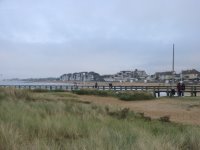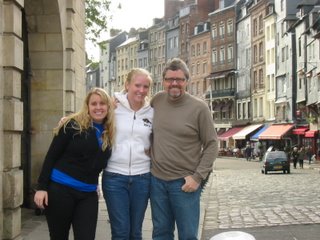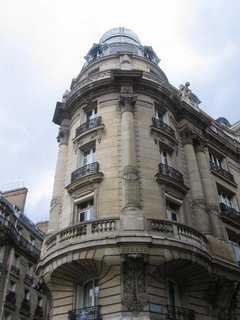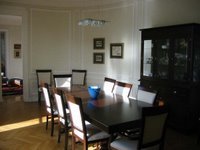Monday, December 25, 2006
Sunday, December 03, 2006
Hearing of the first serious storms of the
 November also seemed to be between seasons. The hoopla leading up to Nouveau Beaujolais day had passed and the great parties to celebrate the rather ordinary wine were over. Most shops hadn’t yet put up their Christmas decorations or other hints of the coming festive season, except for the windows of the wine merchants filled with displays of champagne, a sure sign that spirits will pick up again soon – literally.
November also seemed to be between seasons. The hoopla leading up to Nouveau Beaujolais day had passed and the great parties to celebrate the rather ordinary wine were over. Most shops hadn’t yet put up their Christmas decorations or other hints of the coming festive season, except for the windows of the wine merchants filled with displays of champagne, a sure sign that spirits will pick up again soon – literally.
As always, there is a food aspect to the changing seasons, and in November, the champagne is meant to go with oysters. On a quiet corner a couple of blocks from our apartment I found the
The key Fall/Winter fashion accessory for both men and women in
 November 29th seemed to be a key date when the pre-Christmas season started to gear up. One of the first shops to have decorations up was Maison Pou (translation: House of Pou – sausages our specialty) and others quickly followed. The Christmas lights on the Champs Elysées also came on this week, every tree from the Arc de Triomphe to Place Concorde wrapped in white lights. The huge FNAC store (think Future Shop, HMV Records, Chapters Bookstore and Ticketmaster rolled into one) in our neighbourhood announced it will open the next four Sundays, and Christmas tree lots sprang up on the corners in front of the florist shops. We visited the Christmas market that opened underneath the Grande Arche de la Défense, a modern
November 29th seemed to be a key date when the pre-Christmas season started to gear up. One of the first shops to have decorations up was Maison Pou (translation: House of Pou – sausages our specialty) and others quickly followed. The Christmas lights on the Champs Elysées also came on this week, every tree from the Arc de Triomphe to Place Concorde wrapped in white lights. The huge FNAC store (think Future Shop, HMV Records, Chapters Bookstore and Ticketmaster rolled into one) in our neighbourhood announced it will open the next four Sundays, and Christmas tree lots sprang up on the corners in front of the florist shops. We visited the Christmas market that opened underneath the Grande Arche de la Défense, a modern
As we’re hosting our first larger party this week, we decided to get our Christmas tree early. That will give us more opportunity for Christmas-themed entries in the coming days. Our thoughts are with all our family and friends and we’re happy to be able to share some of our life here with you with this blog. We hope your preparations for a wonderful holiday season are already well underway. A bientôt!
Tuesday, November 14, 2006
Somewhat late, we’ll give you a quick summary of the rest of our
 One day, we took the fairly long drive (90 minutes) to Mont Saint Michel, the famous Abbey that is probably one of the most photographed places in
One day, we took the fairly long drive (90 minutes) to Mont Saint Michel, the famous Abbey that is probably one of the most photographed places in  to buy souvenirs, although Brian was strongly tempted by a full-size suit of armour – perfect for that empty corner of the dining room. Hungry by now, we looked for an appropriate restaurant. There is always a local speciality that one is supposed to try and in Mont Saint Michel it is omelettes. We decided to pass up the famous restaurant Mere Poulard (home of the $30 omelette) which had a crowd waiting anyway and we settled instead on toasted panini sandwiches and McCain french fries in a casse-croute. Hardly gourmet, but the Belgian draft beer (brewed by monks, you know) added a touch of historical authenticity.
to buy souvenirs, although Brian was strongly tempted by a full-size suit of armour – perfect for that empty corner of the dining room. Hungry by now, we looked for an appropriate restaurant. There is always a local speciality that one is supposed to try and in Mont Saint Michel it is omelettes. We decided to pass up the famous restaurant Mere Poulard (home of the $30 omelette) which had a crowd waiting anyway and we settled instead on toasted panini sandwiches and McCain french fries in a casse-croute. Hardly gourmet, but the Belgian draft beer (brewed by monks, you know) added a touch of historical authenticity.
 We decided to take back roads on the return trip to our chambre d’hôte, travelling through Suisse Normande, so named because the hills and valleys of rich farmland are similar to
We decided to take back roads on the return trip to our chambre d’hôte, travelling through Suisse Normande, so named because the hills and valleys of rich farmland are similar to

 On the next day we headed back to
On the next day we headed back to
 We headed onwards to the coast and stopped in Honfleur. This beautiful port town sits at the mouth of the River Seine where it flows into the Channel. It was a centre of impressionist painting and the harbour is subject of many well-known artworks. More important for Canadians perhaps is the fact that Samuel de Champlain sailed from Honfleur in 1608 to found
We headed onwards to the coast and stopped in Honfleur. This beautiful port town sits at the mouth of the River Seine where it flows into the Channel. It was a centre of impressionist painting and the harbour is subject of many well-known artworks. More important for Canadians perhaps is the fact that Samuel de Champlain sailed from Honfleur in 1608 to found
We ate a traditional lunch in a harbourside café - steamed mussels followed by Ben and Jerry’s - before piling into the car for the two-hour drive back to 
Saturday, November 04, 2006
This was quite a moving experience as we drove the coast of
We started at
The Juno Beach Centre was opened in 2003 and is staffed by Canadian student interns on four-month assignments. The exhibits trace Canadian involvement in World War 2 and in the D-Day invasion. We walked out of the museum onto the beach through a steel passageway
built in the size and shape of the D-Day landing craft. We passed old German gun emplacements half sunk into the sand and the tracks of
the tunnels that joined them. Click on the photos below for larger views.


 Wanting a place to build the new harbour, they did not invade the beach at Arromanches as part of the initial invasion. Instead, they captured the area by land later on the day of June 6 and by the next day they had begun the construction of the port and had begun landing ships. It is an incredible achievement of engineering.
Wanting a place to build the new harbour, they did not invade the beach at Arromanches as part of the initial invasion. Instead, they captured the area by land later on the day of June 6 and by the next day they had begun the construction of the port and had begun landing ships. It is an incredible achievement of engineering. Further along the coast at Longues-sur-mer we came across German heavy cannons still sitting in their concrete bunkers on the cliffs, pointing out across the channel. Although they were mostly intact, you could still see where one had been blown apart by incoming fire. The open fields and the small villages with their church spires gave us very vivid images of how it must have felt for the soldiers on those days to face the risks and fears as they moved across the countryside.
Although they were mostly intact, you could still see where one had been blown apart by incoming fire. The open fields and the small villages with their church spires gave us very vivid images of how it must have felt for the soldiers on those days to face the risks and fears as they moved across the countryside.
Here is a short film clip on the landings that day from the History Channel web site.
We made the turn back towards our B and B at  Very picturesque narrow streets lead to the impressive cathedral that dates from the 11th century.
Very picturesque narrow streets lead to the impressive cathedral that dates from the 11th century.
A long day followed by a Sunday dinner in an old auberge, but more about that later.
We have just returned from our first real trip into the country over a four-day weekend. We chose
Travel times are always shorter than expected here, so we used our early arrival to visit
We walked the beach boardwalk with its line of changing huts with the names of actors on each door, impressed by the famous people the resort seems to draw,  until we realised that many of those named have long-since passed on. I guess the idea is to offer the common folks the chance to slip out of their clothes in the Tom Cruise changing room. We didn’t ask the price – the cost of a coffee in the café had already been enough to tell us we won't be spending our summers there.
until we realised that many of those named have long-since passed on. I guess the idea is to offer the common folks the chance to slip out of their clothes in the Tom Cruise changing room. We didn’t ask the price – the cost of a coffee in the café had already been enough to tell us we won't be spending our summers there.
 d'hôte (full course meal) available to their guests for a pretty reasonable fee and prepared by the ‘man of the house’ who then led the conversation over din
d'hôte (full course meal) available to their guests for a pretty reasonable fee and prepared by the ‘man of the house’ who then led the conversation over din for the girls. We stayed three nights and I must say I looked forward each morning to breakfast (must have been the country air): croissants, bread, cheese, three types of jam, butter, café au lait, hot chocolate, yogurt…).
for the girls. We stayed three nights and I must say I looked forward each morning to breakfast (must have been the country air): croissants, bread, cheese, three types of jam, butter, café au lait, hot chocolate, yogurt…).
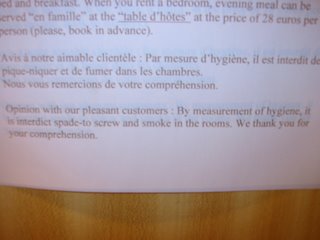
Will post more soon on the rest of our trip.
Sunday, October 15, 2006
 So we have finally figured out how to set up our space to share with you our experience of Europe, France and Paris. Although it's now October, we will go back in time a little bit to tell you about a few of the aspects of our arrival and settling in from August onwards and to share with you a few of the pictures we've taken so far. Hopefully, from this point on, we can begin to post shorter entries about our day-to-day life as well as a few photos.
So we have finally figured out how to set up our space to share with you our experience of Europe, France and Paris. Although it's now October, we will go back in time a little bit to tell you about a few of the aspects of our arrival and settling in from August onwards and to share with you a few of the pictures we've taken so far. Hopefully, from this point on, we can begin to post shorter entries about our day-to-day life as well as a few photos.
 Since this is the first time we (Denise and Brian) have done a blog it's likely to sound a bit more like a family letter or postcard, but as we go along we'll aim for some slightly more profound observations and interesting reading...
Since this is the first time we (Denise and Brian) have done a blog it's likely to sound a bit more like a family letter or postcard, but as we go along we'll aim for some slightly more profound observations and interesting reading...
 Moving in... We were lucky to be able to move directly into our permanent apartment on arrival for only the second time in six postings. Like anything, our apartment comes with certain "avantages et inconvenients". We are in a 100 year old Haussmann building on the fifth floor complete with cage elevator (charming, but very impractical), marble (non-functioning) fireplaces (seven!), 12-foot ceilings, and the gargoyle you see on the left...
Moving in... We were lucky to be able to move directly into our permanent apartment on arrival for only the second time in six postings. Like anything, our apartment comes with certain "avantages et inconvenients". We are in a 100 year old Haussmann building on the fifth floor complete with cage elevator (charming, but very impractical), marble (non-functioning) fireplaces (seven!), 12-foot ceilings, and the gargoyle you see on the left...
We thought that the cage elevator, which holds barely two adults and a dog, and the fact that we're five flights up might  present a few challenges to the movers when our shipment arrived. We should have realized that moving into buildings with cage elevators and lots of stairs is an everyday occurrence in Paris. No problem...they just drive-up with a small truck that has a conveyor-belt-elevator thingy on the top and with a couple of guys at the bottom and a couple at the top - presto....our boxes were magically transported directly into our apartment. We've included a couple of photos of the inside of the apartment too...
present a few challenges to the movers when our shipment arrived. We should have realized that moving into buildings with cage elevators and lots of stairs is an everyday occurrence in Paris. No problem...they just drive-up with a small truck that has a conveyor-belt-elevator thingy on the top and with a couple of guys at the bottom and a couple at the top - presto....our boxes were magically transported directly into our apartment. We've included a couple of photos of the inside of the apartment too...
Shopping... As you can imagine, the food here is amazing. The smell of baking baguettes greets us each time we leave our apartment as we have a boulangerie right next door. Moby really loves Paris - with all of the outdoor cafés, bits of dropped food litter the sidewalks. He keeps his head down when he's being walked so as not to miss anything. We keep our heads down when we're walking him so as not to step in anything! (Actually, the city of Paris seems to be cracking down on Parisiens who do not 'scoop' after their dogs and the city is much cleaner than we had anticipated.)
 Back to the food... Everything is of such a tremendously high quality (and calories!). However, it has taken 'us' some time to get used to not jumping in the car, driving to Loblaws and loading up a grocery cart once or twice a week. Shopping is a
Back to the food... Everything is of such a tremendously high quality (and calories!). However, it has taken 'us' some time to get used to not jumping in the car, driving to Loblaws and loading up a grocery cart once or twice a week. Shopping is a  serious business here and can take a good part of each day (or so it sometimes seems!) Although we don't shop everyday as some French do, we certainly buy baguettes at least once per day (after all, you can't eat a baguette that is even a few hours old!) We also try to buy our produce at one of the local outdoor street markets (the one pictured here is about a ten minute walk from our apartment), our cheese at the fromagerie and our meat at the boucherie. You can see why it takes so long!
serious business here and can take a good part of each day (or so it sometimes seems!) Although we don't shop everyday as some French do, we certainly buy baguettes at least once per day (after all, you can't eat a baguette that is even a few hours old!) We also try to buy our produce at one of the local outdoor street markets (the one pictured here is about a ten minute walk from our apartment), our cheese at the fromagerie and our meat at the boucherie. You can see why it takes so long!
Before our arrival, I had visions of carrying a basket to do my shopping (okay, and wearing a beret too). However, Brian had a different idea! He arrived about ten days before us and proudly presented me with a ... bundle buggy. Of course, in Paris they're called 'marché pousette' and are used when you need to buy too many heavy things to carry. Unlike at home, where they're often only used by 'older' people, here they are used by young and old alike. (Even Hayley agrees to pull it occasion
shopping (okay, and wearing a beret too). However, Brian had a different idea! He arrived about ten days before us and proudly presented me with a ... bundle buggy. Of course, in Paris they're called 'marché pousette' and are used when you need to buy too many heavy things to carry. Unlike at home, where they're often only used by 'older' people, here they are used by young and old alike. (Even Hayley agrees to pull it occasion ally.)
ally.)
Driving... We've driven in Tokyo and New Delhi, but we'll admit that driving in Paris is a two-person job - one to navigate and the other to drive. Since the traffic moves at a fairly fast pace (although the posted speed on the autoroute is 130 kms, it seems that is the minimum speed) it's impossible to concentrate on driving and simultaneously deciding which direction you should be going... So far, Denise has been behind the wheel and Brian has been doing the navigating (more a question of Denise's (lack of) navigational abilities than Brian's driving).
We've driven in Tokyo and New Delhi, but we'll admit that driving in Paris is a two-person job - one to navigate and the other to drive. Since the traffic moves at a fairly fast pace (although the posted speed on the autoroute is 130 kms, it seems that is the minimum speed) it's impossible to concentrate on driving and simultaneously deciding which direction you should be going... So far, Denise has been behind the wheel and Brian has been doing the navigating (more a question of Denise's (lack of) navigational abilities than Brian's driving).
Of course, driving here is exactly as you probably imagined - chaotic and hair raising and that's just driving out of our parking spot! Actually, the metro is so convenient that our car will probably only leave our parking spot on weekends (and away from Paris!) So far, we have had one brief foray into the countryside when we drove to the Loire Valley two Sundays ago. We had a lovely day, which was almost ruined by the horrific traffic we encountered when we returned to Paris. We didn't know that about half of Paris leaves the city each weekend for their country homes. Everyone returns late afternoon or early evening, which causes some pretty amazing traffic congestion for a Sunday night.
However, parking in Paris is actually more of a challenge than driving...If you are lucky  enough to find a parking spot, you're likely to find the cars in front and behind your car have parked right up against your bumper. When we first arrived, I stared in amazement at these 'arrangements' wondering how on earth the person in the middle would ever remove their car from such a tight spot. When I witnessed for the first time how they do get their cars out, I decided we wouldn't be parking our car anywhere in Paris! Basically, the car in the middle simply pushes against the car in the front and then does the same to the car in the back until they can manoeuvre out. I guess they don't call 'em bumpers for nothin'...
enough to find a parking spot, you're likely to find the cars in front and behind your car have parked right up against your bumper. When we first arrived, I stared in amazement at these 'arrangements' wondering how on earth the person in the middle would ever remove their car from such a tight spot. When I witnessed for the first time how they do get their cars out, I decided we wouldn't be parking our car anywhere in Paris! Basically, the car in the middle simply pushes against the car in the front and then does the same to the car in the back until they can manoeuvre out. I guess they don't call 'em bumpers for nothin'...
Despite its quirks, Paris is a city that seems to function pretty efficiently. Garbage is picked up daily and a crew of street cleaners move about the city each morning sweeping and washing the pavement (much to Moby's disgust!) So, apart from the everpresent sound of angry horns and the constant annoyance of having cigarette smoke blown in your face, it's not a bad place to live...
Well, this is only our first entry. Check back next week! Love to hear from you all!















